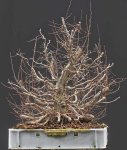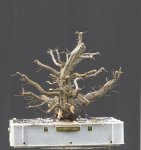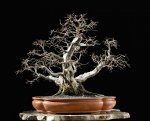Anthony
Imperial Masterpiece
Thank you Mr.Pall.
Anthony
Anthony
Any leafless images, Anthony?For the North Americans -------- Hell Yeah !!! [ to da sorce ]
Guy Guidry - Hackberry
and I believe this image is from maybe 5 to 10 years ago, correct ?
View attachment 171080
Like I said--the thought that America is somehow behind in understanding collected material or "brainwashed" into traditional methods hasn't been the case for twenty years. A simple scroll through here and you will see literally a dozen examples of "NOT old school" treatment of native material, including native hackberries by Ben Oki and Guy Guidry that are pretty notable for their more advanced development in "naturalistic" styles.I show these trees not to show off but to make visible what is possible. Ten years ago, in 2007 I came to Croatia for the firs time to see them working with little trident maples and some trees from a nursery. On the trip down I had seen thousands of excellent collectible hornbeams. I taught them what to look for and to forget everything they have learned about styling of broadleaved trees. They were, as still up to now the majority of American bonsaiists under the impression that the only acceptable form for these trees was the Informal Upright Form with rigid branch placing and NO BIG WOUNDS. Now, ten years later they beat everyone in Europe with broadleaved collected trees. Imagine what these trees will look like in 30 years!
The Informal Upright Form is the form of an ideal pine tree. It is usually not suitable for broadleaved trees. You can quote me.
Now why is this not yet happening in America?
The two trees that I showed so far do not have big wounds or they are closed already after this short time. Thus they might even appeal to fundamentalists. Material for such trees is extremely rare. But it is not necessary to just look for this. We were led to believe that it is written in stone that broadleaved trees must never have big wounds. We are not aware that this notion was invented to help the huge nursery industry in Japan which did not want the competition with trees which were collected in nature just like it is with conifers, where nursery trees find it very tough to compete with collected trees. This is because on conifers big wounds, deadwood is not only OK but desirable.
Imagine if we realizde that we are brainwashed and came to the conclusion that big wounds on broadleaved trees are acceptable and even desirable! End of civilisation!
I am very well aware that this hornbeam is very strange to many who are still in the old school thinking. Well it does appeal to more folks than they like to understand. Anyway, regardless whether one likes it or not, the first image was four years ago and the last one November 2017. Give him ten more years and he will be the gnarly old tree who owns the mountain - ugly but quite impressive. Ugly? Yes, one can impress with ugliness. It is art and not commercial craft for me. A good bonsai does not have to be beautiful, but it must be imprssive.
Now this material dos look more like the stuff they have at Hidden Gardens south of Chicago.
View attachment 171009 View attachment 171010
Excellent inspiration!
You can check out a bunch more at this site.
http://www.animabonsai.com
I don't know who's doing what and where but I find it fun and interesting to look through those trees, quite a few development pics and timeline info there.
I can tell you who is doing what.
This is the collection of my students Marija Hajdic and Andrija Zokic in Kastela, Croatia. The trees shown were designed in numerous workshops lead by me and are regularly revised and brought to the next step in these workshops. What you see is only the tip of the iceberg. They have more than 300 most outstanding trees - ALL broalleaved trees - ALL collected by them, right ther near the Mediterranean coast.
I can tell you who is doing what.
This is the collection of my students Marija Hajdic and Andrija Zokic in Kastela, Croatia. The trees shown were designed in numerous workshops lead by me and are regularly revised and brought to the next step in these workshops. What you see is only the tip of the iceberg. They have more than 300 most outstanding trees - ALL broalleaved trees - ALL collected by them, right ther near the Mediterranean coast.
You can check out a bunch more at this site.
http://www.animabonsai.com
I don't know who's doing what and where but I find it fun and interesting to look through those trees, quite a few development pics and timeline info there.
Thanks. I’m looking. It’s fascinating to view the trees and progression. To me there is a rough and weathered quality to each tree that I find inspirational.You can check out a bunch more at this site.
http://www.animabonsai.com
I don't know who's doing what and where but I find it fun and interesting to look through those trees, quite a few development pics and timeline info there.
Here's a question for you if you have the time and inclination. Nevermind deadwood and large wounds, that's just great character when well done and placed.
I look at many of those trees and think that the more common criticism will be lack of taper in the branches and abrupt transitions from thick to thin too far from the trunk. It's often said that's the crux of good deciduous, that good taper and movement throughout trunk and all the branching and that it takes something like forever to achieve. I'm aware that most of these have less than 10 yrs development behind them so I just take it on faith that those areas will be much improved over the years. (Comparing structure of trees developed for 10 yrs or less to those developed over generations after all here) What do you think? That will just get better and blend over a reasonable number of years? It's just not a problem even now?
Some of them look to me like abrut taper is a temporary flaw that will improve or disappear. (The big oak for example or the Emperor.) Others look like they will always have some long large and kind of strange untapered sections but still spectacular. That's just something we can accept as the character of these kinds of trees? Long term plans to change those or just use them to advantage?



Here an example. You first see the original materiel much like it was collected. Then you see first styling. this is very much what we did at Hidden Gardens. If one only sees this result the conclusion must be that we have no clue what we are doing - this will never look right. Most branches have no or little taper. thick branches were cut short and will forever show the cut. This seems hopeless.
I wouldn't pass something like that up if I saw one in the woods a few years back.Raise your hand if you think this seems hopeless.
LOL!!!Raise your hand if you think this seems hopeless.
